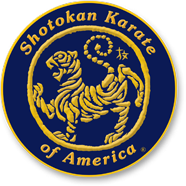What is Karate?
- Karate is defined as “empty hand.” It is a weaponless martial art and means of self-defense that uses all body parts to perform dynamic techniques of offense and defense to their maximum advantage.
Phases of Karate
- Karate practice consists of the following three parts in order:
- Kihon (basics):
- Basics consist of punches, blocks, and kicks that are to be practiced regularly with intensity in order to build the strong foundation for advanced techniques.
- Kata:
- Katas are sequences of basic moves, arranged to display the practitioner’s proficiency. When training, it is ideal to imagine that one is being attacked by multiple attackers and therefore strive to make every technique realistic and effective. Therefore, katas teach the practitioner how to fight multiple opponents at once. There are nineteen katas in Shotokan Karate, as listed below; each has its own speed, intensity, and intricacies that require decades of practice and hard work to learn. A list of kata can be found here or in the drop-down menu under “Karate Practice.”
- Kumite:
- Kumite means “sparring.” This is the third phase of Karate practice where the practitioners will learn two types of kumite: First is one-time engagement; second is three-time engagement.
- Kihon (basics):
- In each category the beginner is given instruction at the most basic level until the techniques become spontaneous to him.
- As the student progresses technically, he progresses physically and his practice demands greater stamina. At this stage he involves himself with the more intricate and difficult katas and more dynamic forms of kumite.
- As the student approaches black belt level, technique, stamina, speed and coordination become natural to him as a result of strong practice. It is at this stage that the serious student discovers that he has only just begun his study of karate. The object of true karate practice is perfection of oneself through the perfection of the art.
Karate as Athletic Training
- The values of Karate to modern man are numerous. In our everyday lives we often forget the value of exercise to both our physical and mental health. The practice of karate tones the body, develops coordination, quickens reflexes, and builds stamina.
Karate as Self-Defense
- Karate is one of the most dynamic of all the martial arts. The trained karateka is able to coordinate his mind and body perfectly, thereby allowing him to unleash tremendous physical power at will. Therefore, it is not the possession of great physical strength that makes a strong karateka; rather it is the ability to coordinate mind and body. Upon developing this ability, even the smallest person finds that he has within himself the power to deliver a devastating blow to any would-be attacker.
Karate to Develop Clarity of Mind
- The serious practice of karate develops composure, a clearer thought process, deeper insight into one’s mental capabilities, and more self-confidence. In this, karate is not an end, but a means to an end. It is an activity in which advancing age is not a hindrance. Rather it encourages proficiency and the keen coordination of mind and body.
